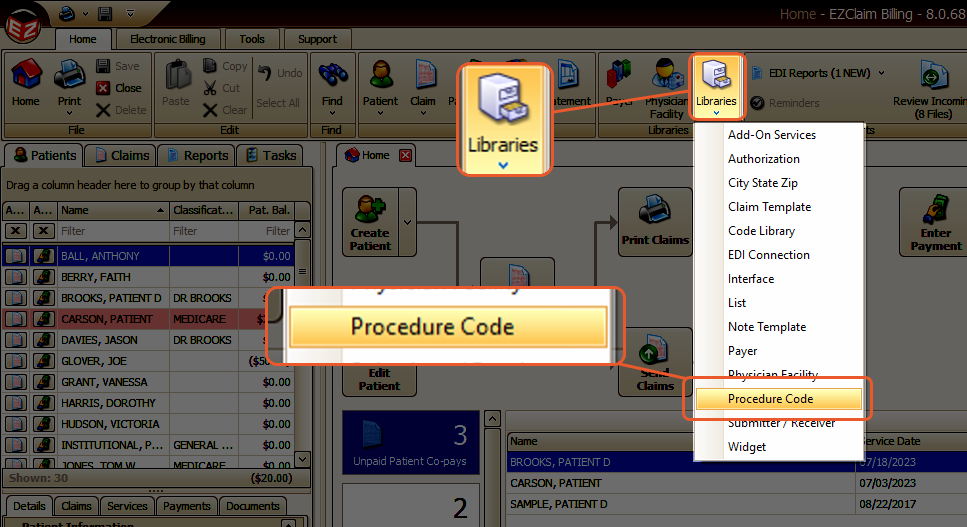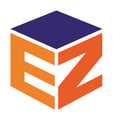This library allows you to maintain procedure (or HCPCS) codes along with rates and additional information for each code
To easily navigate this article, use the links provided below. At the end of each section, click "Back to Top" to return to this menu.
Procedure Code Library Usage (Advanced Topic)
Not Otherwise Classified (NOC) Codes
The Procedure Code Library allows you to maintain procedure (or HCPCS) codes along with rates and additional information for each code. Maintaining the Procedure Code Library is optional and not required.
Accessing the Procedure Code Library

Adding Codes
To add codes to the Procedure Code Library, follow these steps:
- Open the Procedure Code Library
- Click on the row below the filter row
- Enter the procedure code
- Press the tab key to enter additional data
- Continue pressing the tab key until the row is added to the grid
- The new code row will be highlighted in pink until the library changes are saved
Modifying an Existing Code
To edit data, simply click on the cell and make the necessary changes. Press the tab key to save the value. The row will be highlighted in pink until the library changes are saved.
Add Columns
To incorporate additional columns, simply right-click on any column heading and choose Column Chooser. Then, effortlessly drag and drop the customized column to your preferred location.
Available Columns
The grid displays only the most commonly used columns. To customize the view, utilize the Column Chooser option to add or remove columns.
Standard Columns
Procedure – Enter the CPT or HCPCS code here
Mod 1 – If a modifier is commonly used with this procedure code you may enter it here
Charge – Normally contains the unit charge (the amount you charge for 1 unit)
Payer – If this code is specific to a payer, select the payer
- This will allow EZClaim to filter the available codes based on the payer being billed
Description – Description of the code (Used on patient statements)
Additional Columns
To add additional columns, right-click the current column heading and select Column Chooser.
Adjust – Typically left at $0.00
- If you would like a contract adjustment entered at the time of service line data entry, enter the adjustment amount
Allowed – The amount allowed by the payer
- Typically, this is $0.00 but some users like to track the allowed amount before receiving the ERA (EOB)
Attach CMN – If this code requires a CMN to be attached, you can check this box to cause the Attach CMN box on the service line to be checked
Billing Phy – If this code record is for a specific billing provider, you can enter it here
- Sometimes used for different contracted rates for different providers.
Category – User-defined category
- Can be used in custom reports
Cost – Used to fill in the cost amount when entering service lines
Mod 2 – Modifier 2
Mod 3 – Modifier 3
Mod 4 – Modifier 4
NDC Code – The NDC code is automatically populated in loop 2410 LIN02 electronically. This also includes the Drug Unit Count and Drug Unit Measurement, which are filled in loop 2410 CTP04 and CTP05.
- For paper claims, it may be necessary to enter all NDC-related data in the Description field. The printed claims will display the description in the shaded area of Box 24A.
Note – General note field for your reference.
Product – Use the product code to distinguish between generic CPT or HCPCS codes
Rate Class – If you have varying rates for different classes of service such as MD, PA, RN, and more, you have the option to define rate classes in this section. These rate classes can then be used with rendering providers in the Physician Library.
Revenue Code – Code used to describe the service
Set Desc – If checked, the line item description will be filled in with the code description
Set Pat Amt Due – If checked, the service line patient amount due field will be filled in with the patients co-pay amount
Subcategory - User-defined subcategory
- Can be used in custom reports
Units – If you need to charge for multiple units instead of a single unit, you can input the number of units in the Units field. For example, if you charge $35.00 for 3 units, enter $35.00 as the charge amount and 3 in the Units field.
- EZClaim will automatically round to the nearest cent if only 1 unit is used
Start and End – If the procedure code has a specific validity period, you can enter the start and end dates in the Start and End fields.
Work RVU – Used to track the Work Relative Value Unit
- Can be used in custom reports
Malpractice RVU – Used to track the Malpractice Relative Value Unit
- Can be used in custom reports
Modify or Create New
To create new code sets, simply click on the Modify or Create New button. Select the codes you wish to modify and click the button. This will open the Modify or Create New Procedure Code window.
- Check the properties you wish to apply and enter the appropriate values
- To modify the selected codes, click the Apply to Checked Items button
- To create new codes based on the selected codes, click the Create New from Checked Items button.
Importing Procedure Codes
You have the option to import your code libraries. Importing only works with tab-delimited text files.
Note: We do not provide support for converting codes into the correct format.
The following format must be followed in the text file in order to be imported into the code libraries:
Code{TAB}Charge{TAB}Allowed{TAB}Adjust{TAB}Description{TAB}Product Code{TAB}Modifier{TAB}Category{TAB}Subcategory{TAB}WorkRVU{TAB}MalpracticeRVU
To save your file as a tab-delimited text file:
- Google Sheets: Select File → Download → Tab Separated Values (.tsv)
- Excel: Save → click drop-down field → select Text (Tab delimited) (*.txt)
Procedure Code Library Usage (Advanced Topic)
The EZClaim Procedure Code Library streamlines data entry and ensures accurate charge information. By using rate codes and assigning payers, you can efficiently manage multiple rate schedules.
EZClaim uses a decision tree to determine available codes based on the following criteria:
- Billing Physician
- Bill to Payer
- Rate Class
If there are duplicate procedure codes that match the criteria, EZClaim will only display one code. This ensures consistency during data entry, even when the lookup tool is not being used.
For more information on the lookup tool, see the Procedure Code Lookup article
Codes are given priority based on the following criteria in the given order:
- Billing Physician, Bill to Payer, and Rate Class
- Bill to Payer and Rate Class
- Rate Class only
- Codes that do not have the Billing Physician, Bill to Payer, or Rate Class assigned
Additional Information:
- The uniqueness of a procedure code is determined by the combination of the Procedure Code and Product.
- When you change the Procedure Code, the existing Allowed amount will be replaced with the data from the library.
- If there is already a contract adjustment for the service line, the existing Adjustment amount will not be overwritten.
- If the charge amount in the library is $0.00, it will not replace or overwrite an existing charge amount.
- If the allowed amount in the library is $0.00, it will not replace or overwrite an existing allowed amount.
Product Codes
Product Codes are incredibly helpful in scenarios where you need to store distinct charge amounts (or other data points) for the same procedure code. Product Codes provide a way for you to distinguish between the two duplicate codes and keep everything organized.
Input Product Codes into the Product column in the Procedure Code Library.

Note: This column is not enabled by default in EZClaim, so you will need to add it using the Column Chooser.
Start and End Dates
When start and end dates are specified for codes within your Procedure Code Library, certain rules come into effect during Procedure Code Lookup.
- When accessing the lookup library from the Claim Template screen, EZClaim will utilize the current date as the filter criterion.
- If the From date is left blank when accessing the library from the claims service line preview row, the lookup library will not display any codes with start or end dates.
- When accessing the library from a service line, EZClaim will utilize the From date as the filter criteria.
Fee Schedules
Users can utilize the Procedure Code Library to maintain fee schedules for their payers. By assigning allowables to specific payers using the Payer and Allowed columns, users can ensure accurate billing.
The screenshot below demonstrates how different allowed amounts can be assigned to different payers for the same code. The Procedure Code Lookup screen will display only the codes that match the claims payer.
Not Otherwise Classified (NOC) Codes
Definition
A NOC code is a procedure code that falls under the category of Not Otherwise Classified and typically requires a description of the procedure.
Note: It is important to consult your coding references to determine the appropriate classification and description for the procedure code.
There are two approaches to managing NOC codes.
- If the NOC description is consistent, you can utilize the procedure code library (see instructions below)
- If the NOC description varies, you should utilize the service line field. See Other Service Line Fields for information about the NOC Override field.
If your office utilizes NOC codes and submits electronic bills using the ANSI 837 format, it is necessary to properly configure the procedure code library:
- Add the Category column into the Procedure Code library using Column Chooser.
- Enter the word NOC into the Category field
- Enter the NOC description into the procedure Description field.
This will enable EZClaim to automatically export the description into the SV101-7 field in the ANSI 837 file.
If you need to use different descriptions for different products, use the Product Codes feature.
Payer-specific NOC codes and descriptions can be assigned at the Procedure Code Library level. However, it is not necessary to select a payer for the NOC code feature to function correctly.
Revenue Code Entries
If you need to use the Procedure Code Library for entries that solely involve the revenue code column, it is necessary to input the word BLANK into the procedure code field, as a procedure code is still required.
Tip: To ensure that EZClaim accurately retrieves the appropriate charge during a code lookup, you may find it helpful to utilize the product code.
ANSI 837 Information
During the creation of the SV1 segment, EZCLaim utilizes the procedure code library to locate the NOC description based on the NOC code and payer (if necessary). It then inserts this information into Loop 2400 Segment SV1 Field 01 Subfield 7.
Tips
- When modifying the number of units on a service line, please note that the cost column and adjustment column will not be altered. Only the Charge and Allowed columns will be updated.
- To calculate the new charge when adjusting the number of units, divide the current charge by the original number of units to determine the per-unit amount. Then, multiply this amount by the new number of units.
Formula: <New Charge> = <Old Charge> / <Old Units> * <New Units> - The procedure code and product code work together to determine the appropriate library entry to use. The product code column is typically hidden and is reserved for specific circumstances.
Important: After making changes to the existing Procedure Codes, such as updating charge amounts, it is important to re-associate them with any existing Claim Templates and/or Recurring Claims. This ensures that EZClaim uses the updated information going forward.
Please note that existing claims and service lines will not be automatically updated.
